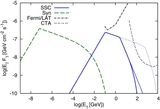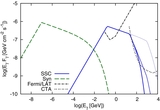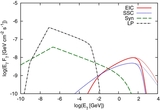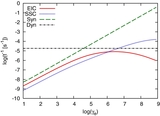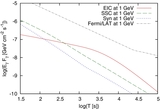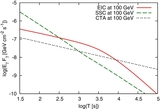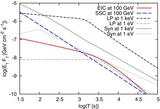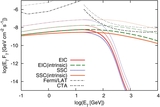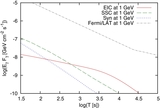Image Details
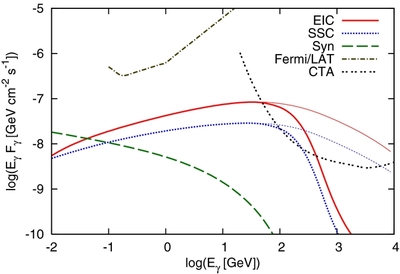
Caption: Figure 3.
Gamma-ray spectra of EIC emission in the late internal dissipation model for GRB afterglows, caused by Compton scatterings
of X-ray photons by electrons accelerated at the external shock. Calculations are numerically performed according to Equation
(39), taking into account the equal-arrival-time surface. The observation time is set to
T = 10
3 s and the source redshift is taken as
z = 0.3. Relevant parameters for the late jet are
L
b
LP|
T′
a
= 10
48.5 erg s
−1,
T′
a
= 10
3 s,
E′
b
= 0.1 keV, α
fl = 0.2, and α
st = 1.5. Relevant parameters for the standard afterglow component are
 ,
,
![]() ef
= 10
−2,
ef
= 10
−2,
![]() Bf
= 10
−3,
n = 1 cm
−3, and
p = 2.4. For comparison, we also show the assumed synchrotron spectrum and the resulting SSC spectrum. Thick curves represent
cases where the EBL attenuation is taken into account, while thin ones do not. Note that the attenuation by pair creation
in the source is considered. The
Fermi/LAT and CTA sensitivities (with the duty factor of 30%) are also overlayed (CTA Consortium 2010).
Bf
= 10
−3,
n = 1 cm
−3, and
p = 2.4. For comparison, we also show the assumed synchrotron spectrum and the resulting SSC spectrum. Thick curves represent
cases where the EBL attenuation is taken into account, while thin ones do not. Note that the attenuation by pair creation
in the source is considered. The
Fermi/LAT and CTA sensitivities (with the duty factor of 30%) are also overlayed (CTA Consortium 2010).
Copyright and Terms & Conditions
© 2011. The American Astronomical Society. All rights reserved.


